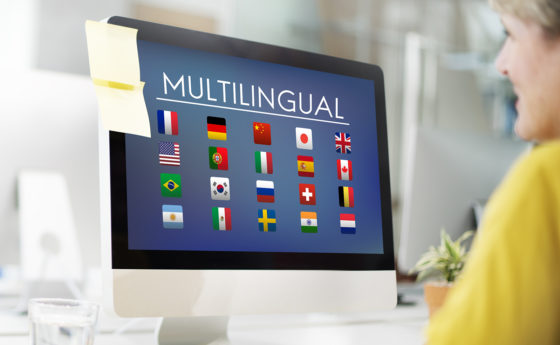
Taking your software business global can open up important new opportunities for your company—whether it’s gaining access to new technologies and talent pools, attracting new customers, or boosting sales and revenues.
To reach new audiences, you’ll need to employ both localization and internationalization. While these two terms are related, they actually play very different roles in the translation process. Both are important for realizing your company’s global ambitions.
What is localization vs. internationalization?
Localization and internationalization are often known by the shorthand terms “l10n” and “i18n” respectively. You may be wondering about the meaning of these abbreviations. They are both numeronyms—or number-based words—in which the digits represent the number of letters omitted between the first and last letters. It’s a faster, easier way to refer to these two key globalization processes.
So, how do these two terms relate to each other? How do i18n and l10n figure into adapting software for global markets? In simple terms, internationalization paves the way for localization.
Internationalization: Adding flexibility to your software
Internationalization is a strategy for making software as adaptable as possible for different languages, regions, and cultures. It helps to ensure that significant changes won’t be needed later on, speeding entry into new markets.
At its core, i18n is about making your software “language agnostic.” That means separating out text from elements that are time-consuming to update such as your software’s code. I18n relies on using standardized encoding and prioritizing ease of adaptation when making design decisions. Done thoughtfully, i18n clears the way for successful translation and localization.
Localization: Making your offerings more relevant and impactful
Localization is the process of adapting your software and related content for a particular market or region. It takes into account language, culture, social mores, and worldview. Localization is crucial for thriving in new markets because people prefer products, information, and experiences that feel tailor-made just for them.
In a 2020 survey, 76% of consumers said they prefer to buy products with information available in their native language and 66% of business buyers said they would pay up to 30% more for a localized product. Savvy businesses increasingly recognize the importance of localization and prioritize investing in it. In fact, the global software localization market is predicted to nearly triple from $5.9 billion in 2022 to $15.6 billion by 2032.
Of course, l10n involves translating text, but it goes far beyond that. Every aspect of the overall experience needs to be adapted for local preferences, needs, and expectations, including:
- Product design, features, and pricing
- Branding and messaging
- Images, graphics, icons, and other visual elements
- Local conventions such as date and time formats, units of measurement, currency, and payment methods
- Cultural references such as idioms, slang, and symbols
- Legal and regulatory requirements
- Customer support, user manuals, and other help desk content
L10n enables your brand to connect with audiences in new markets and delivers powerful benefits for your business, including:
- Improved user experience and increased customer loyalty—L10n makes your software functional for the people who buy it outside of your domestic market. Because localization takes into account language, culture, customs, and preferences, it creates a more satisfying and effective user experience. In turn, this decreases churn and increases loyalty, because people who feel your brand understands them and gives them what they need become repeat customers.
- Increased sales, revenues, and growth—A significant 40% of consumers won’t make purchases that aren’t in their own language. Pricing that’s out of sync with local market dynamics can also turn off potential buyers. Localizing your offering is one of the most important investments you can make to expand your pool of prospective customers. In fact, localizing pricing alone can boost growth by more than 30%. More sales, in turn, translate into increased revenues and profits.
- Greater competitive advantage—Localizing your offering can increase your competitive advantage in two ways. It gives you a decided edge over other global brands that have not invested in localization and also allows you to compete on a more even playing field with local brands.
4 important differences between internationalization (i18n) and localization (l10n)
- Purpose: The goal of i18n is to design and develop software that’s easily adaptable for different languages, cultures, audiences, and locales. L10n, on the other hand, aims to tailor your offerings or content for a specific market.
- Scope: Since i18n takes place during the development phase, it addresses broad, foundational aspects of your software. L10n focuses on the details to make sure your product meets the specific needs and expectations of the intended audience.
- Timeline: Internationalization should be completed before localization can begin. Once a software product has been internationalized, the next step is to localize continuously as updates are released.
- Flexibility: I18n is all about making your software more flexible, creating room for future adaptation. It paves the way for l10n, which focuses on tailoring your product and supporting content for a particular market and making it more relevant for the specific audience.
4 key takeaways about internationalization vs. localization
- Internationalization (i18n) means developing localization-ready software so it can be more quickly and easily launched and maintained across global markets
- Localization (l10n) is the process of tailoring your offerings to the language, culture, customs, needs, and preferences of customers in a particular market or region
- Both i18n and l10n are critical for successfully breaking into new markets and reaping the rewards of globalization, such as an expanded customer base, deeper talent pool, boosted sales and revenues, increased profits, and greater competitive advantage
- While these two processes are related, they differ significantly from one another in terms of purpose, scope, timeline, and flexibility. I18n typically occurs earlier, is more general, focuses on adaptability, and helps to pave the way for l10n
Global expansion requires the right translation and localization partner
As we’ve seen, internationalization and localization are two critically important processes as your business moves into new international markets. Of course, there’s a lot of complexity to navigate on your way to global success. An experienced translation and localization partner can help to simplify and streamline the process.
At Acclaro, we create tailored solutions to help you reach customers in more than 125 languages. Our dedicated teams of experts provide the guidance, support, and specialized services you need to help fuel your global expansion.
Get started today to learn more about how Acclaro can help you succeed in any market.
Insights for global growth

Power your strategic growth
Go beyond tactical localization with tailored, strategic solutions that resonate locally and drive growth globally.
Get started


